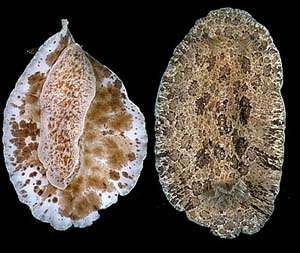
Discodoris lilacina
(Gould, 1852)
Order: NUDIBRANCHIA
Suborder: DORIDINA
Family: Dorididae
DISTRIBUTION
Common in the tropical and subtropical Indian and Pacific Oceans.
PHOTO
Koumac, New Caledonia, Oct 1993, intertidal, 120 mm long alive. Photo: Bill Rudman.
The genus Discodoris contains a very large number of very similar if not identical species. Because the original descriptions were often inadequate and based on one or a few specimens, it is difficult to determine their identity with living material. Until we have a better idea as to whether we are dealing with one widespread variable species or a number of very similar looking species, the taxonomy will remain confused. One of these species, is commonly identified with D. fragilis Alder & Hancock. The earliest name for this species is Doris lilacina Gould. It is possible that D. concinna Alder & Hancock, 1864 and various of Bergh's many species will prove to be synonyms.
This species is characterised by its ability to autotomise large sections of the mantle as described by many authors. There are two white patches in the dorsal midline which are quite characteristic of the species (see Willan & Coleman, 1984: figs 108, 111), but sometimes obscured in heavily pigmented specimens. The name, D. fragilis, which well describes its tendency to autotomise sections of the mantle, is in fact predated by the name Doris lilacina, from the Hawaiian islands. Gould in his original description, likens his specimen to a `trilobite' not realising that the peculiar shape resulted from the almost total autotomy of the mantle skirt, only the anterior portion being retained.
See Page on 'Discodoris lilacina' and 'Discodoris fragilis' from the eastern Atlantic and Mediterranean.
- Gould, A.A. (1852). United States Exploring Expedition during the Years 1838-1842. Mollusca & Shells, 12: 1-510. (with Atlas of Plates, 1856).
Rudman, W.B., 1999 (July 21) Discodoris lilacina (Gould, 1852). [In] Sea Slug Forum. Australian Museum, Sydney. Available from http://www.seaslugforum.net/find/disclila
Related messages
Discodoris lilacina from sthn Queensland
December 18, 2008
From: Gary Cobb
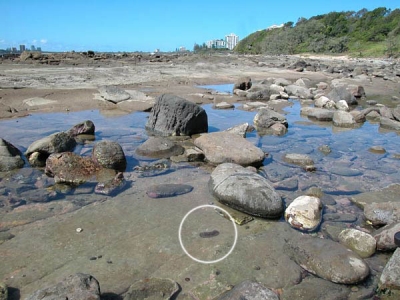
Concerning message #21190:
Hi Bill and everyone!
May I present to the Forum perhaps the largest opisthobranch we find here intertidally.
Locality: Mooloolaba, Sunshine Coast, 50 mm, Queensland, Australia, Pacific Ocean, 30 June 2007, Subtidal. Length: 15-120 mm. Photographer: Gary Cobb.
Cheers Gary
gary@nudibranch.com.au
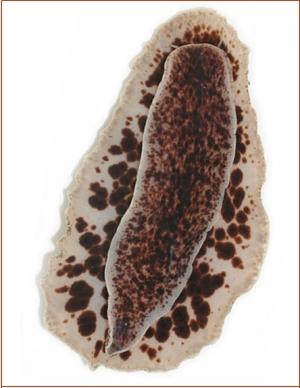
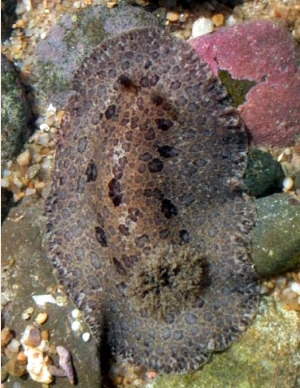
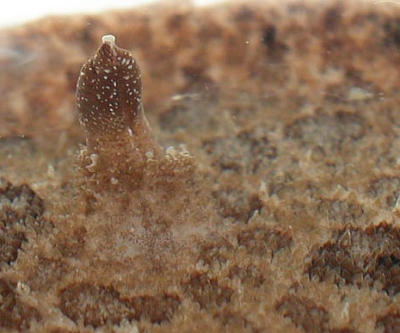
Dear Gary,
Thanks for these photos. As your upper one shows, this is a hardy species whihch can sometimes be found even in upper tidal pools where they are in grave danger of cooking! In your lower photo we can see the papillae which cover the mantle and usually have a nipple-like tip. In the earlier message I mentioned Alder & Hancock's two species D. fragilis and D. concinna. Charles Eliot, who re-studied Alder & Hancock's specimens considered the two species could possibly be separated by the nature of the tubercles on the mantle. He described the tubercles of D. concinna as crowded and often with a raised tip as in your photo. Unfortunately the preserved material of D. fragilis was in pieces - probably due to the breaking up of the mantle on preservation - but he considered that the tubercles were not as crowded and different in appearance. I must say I have spent many hours trying to distinguish any differences in living specimens, but have been unable to find two 'tubercle types'. Until someone can show me some differences, I find the only practical solution is to use the oldest available name - Discodoris lilacina.
-
Eliot, C. N. E. (1906) On the nudibranchs of Southern India and Ceylon, with special reference to the drawings by Kelaart and the collections belonging to Alder & Hancock preserved in the Hancock Museum at Newcastle-on-Tyne. Proceedings of the Zoological Society of London, [for 1906], 2, 636-691.
Best wishes,
Bill Rudman
Discodoris lilacina from Townsville, QLD
December 16, 2008
From: Melanie Wood
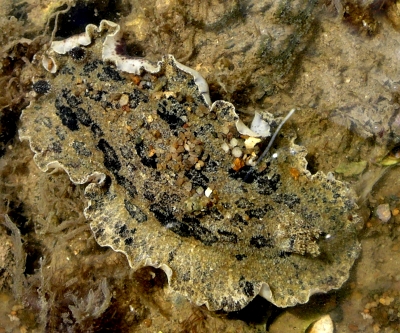
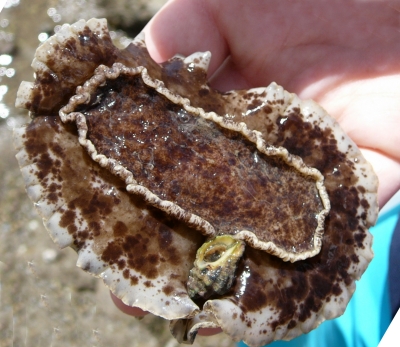
Hi,
This nudibranch, which I have identified as Discodoris concinna is often seen at one of our local haunts, Rowes Bay. Most students find this species rather drab and boring but I find them beautiful and majestic when I see them moving in the water.
Locality: Rowes Bay, Townsville, Low tide, exposed, Qld, Australia, 7 September 2007, Intertidal muddy. Length: Approximately 7 cm. Photographer: Melanie Wood.
Thanks
Mel
deadlegsmel@hotmail.com
Wood, M.J., 2008 (Dec 16) Discodoris lilacina from Townsville, QLD. [Message in] Sea Slug Forum. Australian Museum, Sydney. Available from http://www.seaslugforum.net/find/21190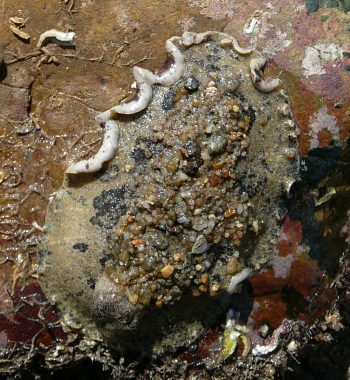
Dear Mel,
Compared with a beautiful aeolid or chromodorid I think you would have to be a little bit biased to describe them as 'beautiful' but certainly the contrast between the drab camouflaged dorsal side and the colours of the underside are quite startling - but as they say 'beauty is in the eye of the beholder'.
Concerning its name. Alder & Hancock (1864) described two species from India Doris fragilis and Doris concinna which I suspect are the same species. They mention that Doris fragilis, as its name implies, breaks off bits of its mantle skirt. The earliest name for this 'fragile' one is Discodoris lilacina (Gould, 1852).
Best wishes,
Bill Rudman
Spawn of Discodoris lilacina from Reunion
August 1, 2008
From: Hugues Flodrops
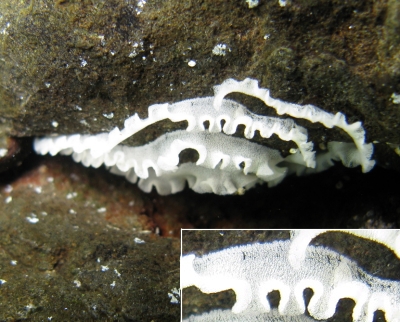
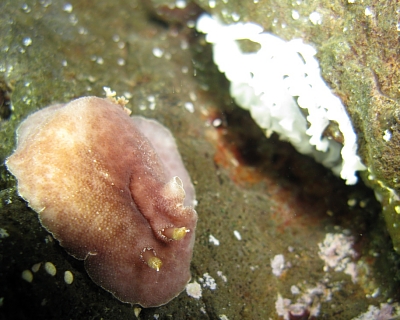
Dear Bill,
I couldn't find in your forum any picture of the spawn of Discodoris lilacina. I found Discodoris lilacina spawning at night. In the first picture, you can see the egg ribbon structure. I hope it's interesting for the forum.
Locality: Etang Salé "Permanent Pool", 1 metre, Reunion Island, Indian Ocean, 9 march 2008, Night. Length: 40 mm. Photographer: Hugues Flodrops.
Best regards.
Hugues.
hugues.flodrops@wanadoo.fr
Flodrops, H., 2008 (Aug 1) Spawn of Discodoris lilacina from Reunion. [Message in] Sea Slug Forum. Australian Museum, Sydney. Available from http://www.seaslugforum.net/find/21475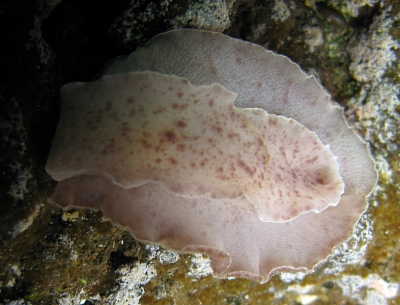
Dear Hugues,
Thanks for this record. I have observed it spawning many times - but usually in a container after collecting a specimen - so I don't have a good photo. This relatively narrow ribbon with a very frilly edge is very characteristic of the species. Thanks also for the photo of the underside.
Best wishes,
Bill Rudman
Discodoris lilacina from the Philippines
July 12, 2007
From: Sylvain Le Bris
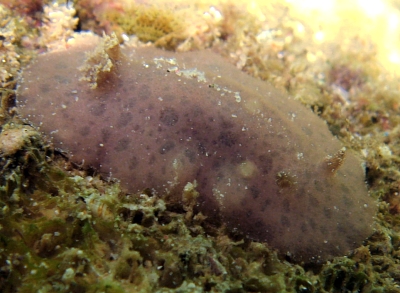
Dear Bill,
Can you help me to identify this nudibranch, found under a rock in shallow waters ?
Locality: Sabang, 1.5m, North Mindoro, Philippines, South China Sea, April 2007. Length: 5cm
Thanks
Sylvain Le Bris
sylvain.lebris@freesbee.fr
Le Bris, S., 2007 (Jul 12) Discodoris lilacina from the Philippines. [Message in] Sea Slug Forum. Australian Museum, Sydney. Available from http://www.seaslugforum.net/find/20073Dear Sylvain,
This is almost certainly Discodoris lilacina.
Best wishes,
Bill Rudman
Discodoris lilacina or Platydoris ellioti ?
June 8, 2007
From: Yukari Tani
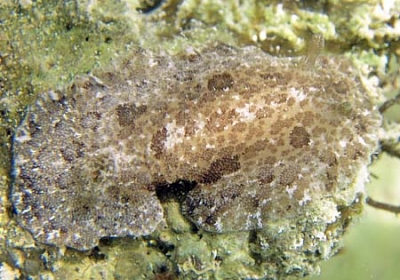
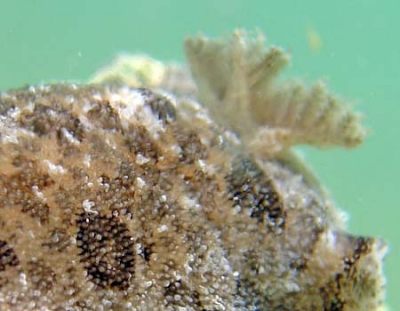
Dear Dr.Bill,
I attach 3 pictures.
Would you tell us ID of this animal, Discodoris lilacina or Platydoris ellioti, please ?
Locality: Eelgrass Beds, Garapan, 0.60m, Saipan, Northern Mariana Islands, Pacific Ocean, 3 September 2006, under the dead coral. Length: 40mm. Photographer: Yukari Tani.
Best regards,
Gon
dswith@isletwind.com
Yukari Tani, 2007 (Jun 8) Discodoris lilacina or Platydoris ellioti ?. [Message in] Sea Slug Forum. Australian Museum, Sydney. Available from http://www.seaslugforum.net/find/19231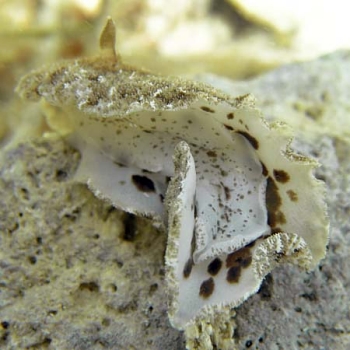
Dear Gon,
This is Discodoris lilacina. It tends to be grayer in colour than Platydoris ellioti which in my experience seems to be a more reddish brown colour. The other difference is that the underside of P. ellioti has a brown margin around the mantle edge which is absent in D. lilacina. Another difference is that the large spots on the underside of the mantle in P. ellioti are a deep red-brown colour with a clear edge, while in D. lilacina they are just brown with a more 'fuzzy' diffuse edge
Best wishes,
Bill Rudman
Discodoris lilacina from the Red Sea
November 5, 2005
From: Binyamin Koretz
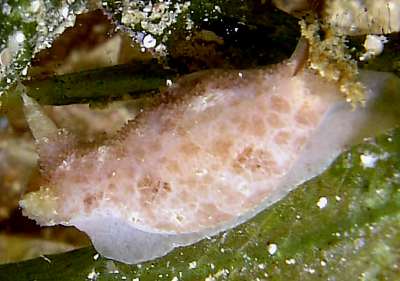
Hi Bill,
Is this Discodoris lilacina? Although known from the Red Sea (usually as Discodoris fragilis ), it's seldom seen here in Eilat.
Locality: Eilat, Satil Area, Israel. Red Sea (Gulf of Eilat). Depth: 21 m. Length: 2 cm. 15 October 2005. sea grass and patch reef. Photographer: Shulamit Koretz
Thanks and best regards
Binyamin
binyamin@koretz.net
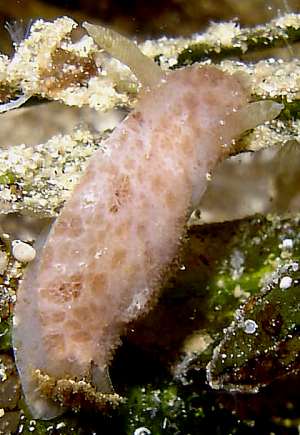
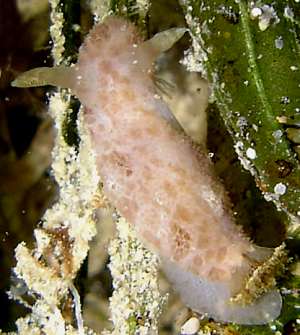
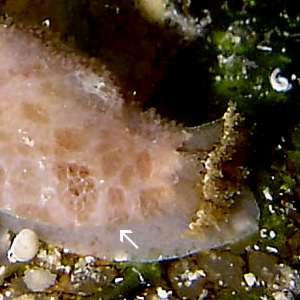
Dear Binyamin,
Yes this is Discodoris lilacina. As your photos show, this species is a classic example of autotomy, the phenomenon where an animal can break off part of its body, usually for defensive purposes. This species often breaks off part, or in this case, all its mantle skirt. That is why the gills look too far back on the body, and the rhinophores look too big for the size of the animal. The name fragilis, meaning fragile, would have been a very appropriate name for this species but D. lilacina is older.
Best wishes,
Bill Rudman
Discodoris lilacina from Turkey
January 26, 2003
From: Ferda Buyukbaykal
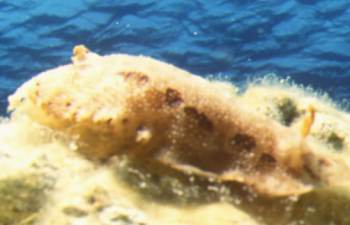
Dear Bill,
Could you identify this photo?
Image Data: Cesme-Izmir, June 1998, 8-10mt, 5-7cm, Algae covered rock.
Ferda
ferdabbaykal@isnet.net.tr
Buyukbaykal, F., 2003 (Jan 26) Discodoris lilacina from Turkey. [Message in] Sea Slug Forum. Australian Museum, Sydney. Available from http://www.seaslugforum.net/find/8941Dear ferda,
As far aa I can see from the photo, I suspect this is the Indo-West Pacific species, Discodoris lilacina, which has been recorded a number of times from the Mediterranean, usually under the synonym Discodoris fragilis. Another lessepsian migrant.
Best wishes,
Bill Rudman
Dorid from Fly Point, Nelson Bay - Australia
December 11, 2002
From: Dave Harasti
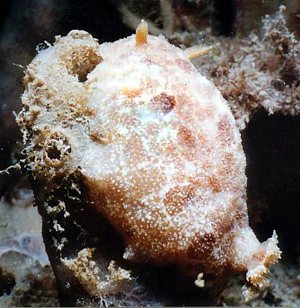
Hi Bill,
I am having difficulty identifying this species. I found the animal on a night dive at Fly Point, Nelson Bay, NSW - Australia in November 2002 in about 10 metres of water.
A friend of mine thought it be Doris cameroni but I'm not so sure. I would love some assistance in the ID.
Cheers,
Dave
diving@webone.com.au
Harasti, D., 2002 (Dec 11) Dorid from Fly Point, Nelson Bay - Australia. [Message in] Sea Slug Forum. Australian Museum, Sydney. Available from http://www.seaslugforum.net/find/8588Dear Dave,
This is Discodoris lilacina. I thought at first that the 'structure' at the bottom right of the photo was the gills, but I think it is an anemone.
Cheers,
Bill Rudman
Discodoris lilacina from Japan
October 1, 2001
From: Nishina Masayoshi
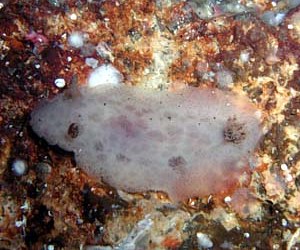
Dear Dr.Rudman,
I think this is Discodoris lilacina. Although it is simple tone, I like to see this kind of animal.
Date: 21 April 2001
Location: Hachijo Is. Japan
Depth: 12m
Length: 30mm
Frequency on Hachijo: uncommon
Best Regards,
Nishina Masayoshi
nishina@hpe15.wips.co.jp
Nishina, M., 2001 (Oct 1) Discodoris lilacina from Japan. [Message in] Sea Slug Forum. Australian Museum, Sydney. Available from http://www.seaslugforum.net/find/5044Dear Nishina,
It seems that smaller specimens of Discadoris lilacina are quite translucent in colour. You can see the darker patch of the viscera about a third the way down the body. At this size they seem quite capable of changing colour from almost translucent white to quite dark brown.
Best wishes,
Bill Rudman
Discodoris lilacina from New South Wales
May 16, 2000
From: D. & L. Atkinson

Hi Bill,
Judi Martin has taken some pics of nudis which we are having trouble identifying.
I scanned them off slides, so they are not very clear. They are from Little Beach, Port Stephens, New South Wales [Australia].
David & Leanne Atkinson
atkin@hunterlink.net.au
Atkinson, D. & L., 2000 (May 16) Discodoris lilacina from New South Wales. [Message in] Sea Slug Forum. Australian Museum, Sydney. Available from http://www.seaslugforum.net/find/2385Dear David & Leanne,
This is Discodoris lilacina which is a common tropical Indo-West Pacific species. One feature of the species is that when disturbed it can break off all or part of its mantle skirt. See the page on Autotomy.
The mantle skirt in this photo seems to be missing on the right hand side, but it may just be folded down and hidden in the shadow.
Best wishes,
Bill Rudman.
Discodoris lilacina from South Africa
July 25, 1999
From: Ernest C.J. Seamark
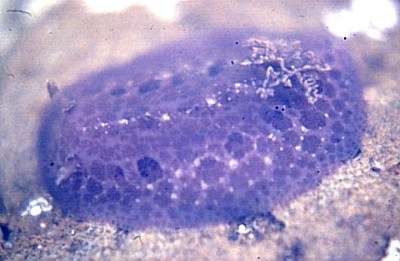
This specimen was collected 13 Dec 1997 at Treasure Beach intertidal zone, South Africa. When photographing in a tub into which formalin had spilt, this species contracted and the notum split into two large "scales", which came off the notum. Do other nuds have this hard scale covering over the notum.
[Treasure Beach is in Durban, KwaZulu Natal, South Africa.]
kearneyt@biology.und.ac.za
Seamark, E.C.J., 1999 (Jul 25) Discodoris lilacina from South Africa. [Message in] Sea Slug Forum. Australian Museum, Sydney. Available from http://www.seaslugforum.net/find/1049Dear Ernest,
This is Discodoris lilacina. One chracteristic of this species is its ability to break off all or parts of the mantle skirt when it is disturbed .. and I guess being bathed in formalin would count as being upset. This ability to break off parts of the body, like a skink breaks off its tail, is called autotomy. Look at the autotomy page for examples of some of the opisthobranchs that are able to do this. In fact another name for this species is Discodoris fragilis - the 'fragile' Discodoris - and the original description of D. lilacina likened it to a trilobite in shape, because the specimen examined had cast off all the mantle skirt except around the head.
Bill Rudman.
Rudman, W.B., 1999 (Jul 25). Comment on Discodoris lilacina from South Africa by Ernest C.J. Seamark. [Message in] Sea Slug Forum. Australian Museum, Sydney. Available from http://www.seaslugforum.net/find/1049Discodoris lilacina from NW Australia
May 10, 1999
From: Clay Bryce
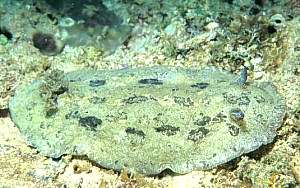
Dear Bill,
Here is another species from the Dampier Archipelago in the Kimberley region, Northwestern Australia.
WAM1455: Is this Discodoris lilacina or D. concinna or something else. These D. fragilis type animals drive me to distraction!
Clay Bryce,
W.A. Museum
Perth.
brycec@museum.wa.gov.au
Bryce, C., 1999 (May 10) Discodoris lilacina from NW Australia. [Message in] Sea Slug Forum. Australian Museum, Sydney. Available from http://www.seaslugforum.net/find/836Dear Clay,
It certainly fits my idea of Discodoris lilacina. I may be wrong, but it beats being driven to distraction!
Bill Rudman.
Juvenile Discodoris lilacina?
May 5, 1999
From: Rie Nakano
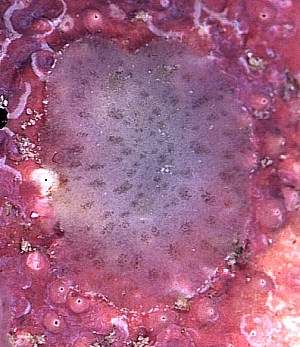
Dear Bill,
Here is another of Mr Atsushi Ono 's images from Kerama Island, near Okinawa which you offered to identify for us.
It was found in the bay, Depth: Intertidal, Length: 6mm.
Rie Nakano
rie@street.ne.jp
Nakano, R., 1999 (May 5) Juvenile Discodoris lilacina?. [Message in] Sea Slug Forum. Australian Museum, Sydney. Available from http://www.seaslugforum.net/find/832Dear Rie,
I think this is a juvenile form of Discodoris lilacina. There are a number of relatively common large 'flat' dorids which I suspect are all forms of the same species, though I would be happy to hear other people's views. At present I know of no good characters to separate the various colour forms. If they are all one species, it appears that the juveniles are more transparent in colour, as in your photo. What they all seem to have in common are two or three white or white and brown patches in the dorsal midline and the habit of breaking off the mantle skirt when they are disturbed.
Best wishes,
Bill Rudman.
Discodoris fragilis? from sthn Queensland
December 1, 1998
From: Wayne Ellis
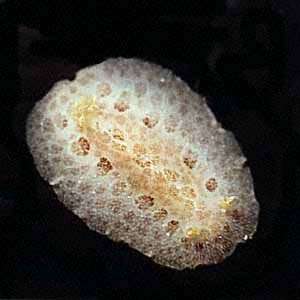
Dear Bill,
Attached is a pic from the Sunshine Coast, southern Queensland that I would appreciate an ID for.
Thanks,
Wayne Ellis
glaskin@ozemail.com.au
Ellis, W., 1998 (Dec 1) Discodoris fragilis? from sthn Queensland. [Message in] Sea Slug Forum. Australian Museum, Sydney. Available from http://www.seaslugforum.net/find/351Dear Wayne,
I might as well stick my neck out and say that I think that this is a form of Discodoris lilacina which is also know as Dicodoris fragilis.
There seems to be quite a few names around for this animal which is not surprising since it is one of the commonest of the larger intertidal dorids in the tropical Indo-West Pacific. If I am correct then it ranges in colour from pale almost white to quite dark brown. In my experience, though I have not done any controlled experiments, individuals also seem to be able to change colour over a few hours to match their background colouration.
Bill Rudman.
Rudman, W.B., 1998 (Dec 1). Comment on Discodoris fragilis? from sthn Queensland by Wayne Ellis. [Message in] Sea Slug Forum. Australian Museum, Sydney. Available from http://www.seaslugforum.net/find/351Discodoris from Nelson Bay
January 27, 1998
From: David & Leanne Atkinson
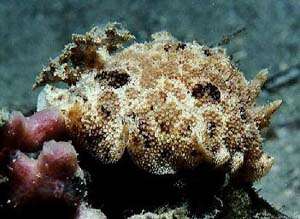
This is from Nelson Bay, Port Stephens, New South Wales, off shore from the Fisherman's Co-op. 5 April 1997.
Thanks,
David & Leanne Atkinson.
atkin@hunterlink.net.au
Atkinson, D. & L., 1998 (Jan 27) Discodoris from Nelson Bay. [Message in] Sea Slug Forum. Australian Museum, Sydney. Available from http://www.seaslugforum.net/find/51It is Discodoris lilacina. One of the many names that has been given to this common tropical dorid is Discodoris fragilis in recognition of the 'fragile' mantle skirt which the slug can break off when it is disturbed.... Bill Rudman
Rudman, W.B., 1998 (Jan 27). Comment on Discodoris from Nelson Bay by David & Leanne Atkinson. [Message in] Sea Slug Forum. Australian Museum, Sydney. Available from http://www.seaslugforum.net/find/51